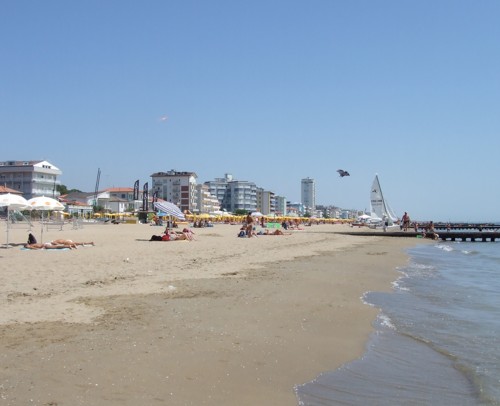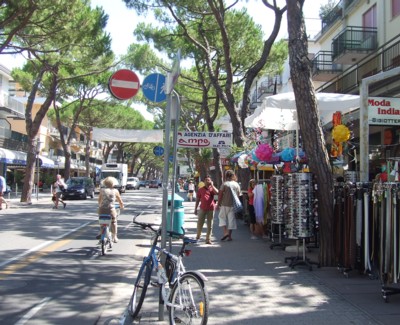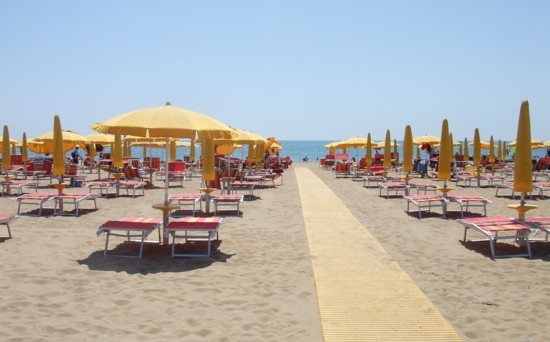About Lido di Jesolo
Lido di Jesolo is a purpose-built beach resort in north-east Italy, on the Adriatic Sea close to Venice. Its miles of sandy beach, rows of sunbeds and night-time entertainment attract thousands of holidaymakers every summer. Billed by tour operators as the “Venetian Riviera”, this is one of Italy’s few package sun-sea-and-sand destinations.
At the beginning of the twentieth century, Jesolo (pronounced YEZolo) was a small and insignificant mainland settlement in the Veneto region. Located near the northern end of the Venetian lagoon, Jesolo also happened to lie in proximity to a long sandy seashore. As beach holidays became the fashion, these miles of sand became a resource to exploit. By the 1950s a whole new town began appearing along this flat, sandy coastline. ‘Lido di Jesolo’ means Jesolo’s seaside, and this beach-side town now dwarfs the centro storico of old Jesolo, a few miles inland. Nowadays, when Italians say Jesolo, they usually think of the Lido.
Entirely shaped by tourism, Lido di Jesolo is very different to the typical Italian town. Its layout, its shops and its services are all designed for the convenience of the resort’s summer visitors, giving it a rather strange and unreal atmosphere. Existence here feels very sheltered: clean, well-organised and safe. There are first-aid points and life guards, sunbeds and showers, snack-bars and ice-cream shops, mini-golf and climbing frames.
The town is strung along ten miles of beach, only extending inland for a very short distance (as little as two or three streets). Beyond this are car parks, access roads and building sites. There is one main street – with several name changes – running along the length of the town, busy with shops selling cheap clothes and beach goods. There are scores of restaurants, snack bars, cafes and ice-cream parlours. You can hire bicycles or gamble in an amusement arcade. In the evenings the street is pedestrianised encouraging holidaymakers to wander, shop, eat and drink to their hearts’ content.
Although the town is very active at organising attractions and events (from underwear catwalk parades to firework displays), there really isn’t a lot of culture here. This isn’t a destination for an active sightseeing tourist; you can make day trips into Venice but the journey is a slow one.
Lido di Jesolo is not the same as Venice Lido (Lido di Venezia), which is an island several miles to the south-west, between the Venice and the sea. The word Lido just refers to the seashore.
> Recommended hotels in Lido di Jesolo
Find and book hotels in Lido di Jesolo. With location maps and guest reviews.
About the beach

Lido di Jesolo has a ten-mile long beach made of yellow dolomite sand. Along the back of the beach is a long paved walkway, running between the sand and the many hotels which face directly onto the beach. The town’s main street is a couple of blocks inland, with many small lanes connecting the beach with the road.
The long beach is divided into different stabilimenti, beach concessions or bathing establishments, with their own rows of distinctive-coloured parasols. These private beaches all rent out sunbeds (lettini) and parasols (ombrellone). They have open showers along the beachside path, toilets and changing cabins. At convenient intervals along the beach are bars serving drinks, sandwiches, salads and ice cream, meaning that you never actually need to leave the beach. There are also small play areas for children. Hotels may have their own rows of sunbeds, or an arrangement with a beach. Sunbeds aren’t necessarily included in the price of your hotel room, so check with your hotel.
Sample prices from the Arenile dei Pioppi beach establishment: a parasol with two sunbeds costs from 14 – 21 per day, depending on what row you choose. Cheaper prices are available from 2pm and from 4pm. There are also weekly, monthly and seasonal rates. You can check the latest prices using the links panel on the right.
If you don’t want to pay for the beach – although this goes against the whole Jesolo culture of beach comfort – there is some free beach (spiaggia libera). A short stretch is located not far from Piazza Brescia. This is not cleaned to the same high standard as the private beaches (cigarette ends in the sand), and you’re advised not to swim due to the lack of lifeguards. Alternatively, you can walk along the water’s edge in front of the sunbed ‘farms’ and just put your towel down on the sand, if you are brave enough.
> More about Italian beach culture
Things to do in Lido di Jesolo
The beach is what holidaymakers come here for. Apart from sunbathing, swimming and lazing around, there are a few other options, although nothing to really grab the imagination.
There are various activities and shows aimed at families with children, such as aquariums and exhibitions about sharks. A boat called the Jolly Roger cruises along the shore offering a pirate experience for all the family in ‘the craziest galleon in the world.’ Children will be keen to visit Aqualandia, a big water/fun park at the western end of town. Alongside the theme park is one of Jesolo’s many mini-golf courses.
Temporary exhibitions and shows provide some extra entertainment for when you get bored of the beach. Lido di Jesolo hosts an annual sand-sculpture festival in June/July. When I visited the theme was the Wild West, with sculptures of famous figures, scenes and even the Battle of Little Bighorn recreated in sand – the 1.50 entrance fee was very well-spent. On the Italian festival of Ferragosto (15th August) there is a big firework display on the beach; and also in August is an annual air-show featuring Italy’s version of the Red Arrows, the Frecce Tricolori.

Some of the town’s entertainment seems stuck in the decades during which Jesolo was developed. Coming to Lido di Jesolo and renting a flat for the summer has become a tradition for the Italian families who turn up each year, rather like going to Butlins, and they’re in no hurry to change things. Some of the town’s proudly-advertised entertainments when I visited were beauty contests and an event billed as ‘sexy wrestling.’ Despite the frequent lack of sophistication, Lido di Jesolo is nevertheless famous for its nightlife, and young people not only holiday here, but drive from local towns to party on the beach.
Lido di Jesolo’s main tourist information office is in an imposing building which emphasises tourism’s status here. In a spacious interior beneath the fluttering flags, helpful staff can provide you with free maps and information. The office is located on Piazza Brescia, a couple of streets inland from the beach.
Old Jesolo has nothing much to boast about except the ruins of an ancient church, but if you fancy getting a sense of the town’s history, you can reach the inland centre by taking ATVO’s local bus service.
Lido di Jesolo transport
Lido di Jesolo is easily reached from the UK. Easyjet and British Airways both offer cheap flights to Venice Marco Polo Airport, which is only a few miles away. There’s a direct bus service between the airport and Lido di Jesolo, operated by ATVO.
There are three urban bus routes within the town. The routes and bus numbers are indicated on the free map from the tourist information office. Tickets should be bought in advance at news-stands, tabacchi or at the bus station. Note that the bus station in Piazzale Picchi is rather out-of-the-way and getting there on foot isn’t particularly pleasant (due to wide roads without pavements and construction sites). This is the terminus for longer distance buses, but if your bus (such as the 5 for Punta Sabbioni) passes through the main part of the resort you’re better off catching it at a stop near your accommodation than trekking here.
Things to do around Lido di Jesolo
Lido di Jesolo doesn’t have a railway station, but if you hire a car or use public transport you can see more of the area. Venice is the most obvious day trip destination (more below on your transport options). You can travel into the rest of the Veneto by bus, with changes to longer distance buses or trains at Mestre or San Donà di Piave. There are more seaside resorts south of Jesolo along the narrow peninsula which forms a barrier between the northern lagoon and the sea. This long stretch of reclaimed land, the Litorale di Cavallino, is mostly agricultural, with a few modern settlements and beaches along the sea. It’s popular with German-speaking sun-seekers, to judge by the many signs in German offering rooms to let, campsites and free wine tasting.
Day trips to Venice
There is a choice of ways to get to Venice from Jesolo for a day trip. Or indeed for travelling in the opposite direction, if you are staying in Venice and want to move on to Jesolo or pay it a visit. There is an ATVO bus which runs all the way to Piazzale Roma, Venice’s bus terminus. There is also a direct boat service, Moby Dick II, which makes excursions from the Jesolo beach to Venice, Burano, Murano and Torcello.
The best combination of affordable and interesting is by using a public transport combination of bus and boat, however. From Jesolo you take ATVO bus number 5 to Punta Sabbioni, its final destination. The bus runs from the autostazione in Jesolo, stopping a few times along the main street. The journey takes 35 minutes and is timed to coincide with an ACTV ferry which leaves Punta Sabbioni for Venice. Both buses and boats run every half-hour. The ferry jetty is close to the bus stop: there may be queues for tickets. As well as Venice, services run to the island of Burano, where you can change for Torcello and Murano. You can buy an all-in return ticket in Jesolo, but if you want to use boats within Venice, consider whether to get a Venice travelcard, which will include the ACTV ferry.The LN ferry runs between Punta Sabbioni and San Zaccaria in Venice, which is very close to St. Mark’s Square. In between it calls at Venice Lido. Some of the boats on this route are double-deckers with great views over the lagoon. Note that there are various variations of the LN’s route: read the signs or ask a crew member if you have any doubts.
If you are travelling in the opposite direction, from Venice to Jesolo, take the ferry from the San Zaccaria (Pietà) stop, on the Riva degli Schiavoni by the tall Pietà church. At Punta Sabbioni you can buy bus tickets from the little wooden ATVO kiosk or from the newspaper and cigarettes shop (labelled ‘T’) opposite the ferries. Hop off the bus while it heads along Jesolo’s main street; there’s a stop by the conspicuous tourist information office on your left and another a few hundred yards further on.
My Kindle guidebook A Day in Venice gives advice and descriptions for spending a day in Venice, and includes a sightseeing walk which you can pick up at San Zaccaria.
Lido di Jesolo hotels
Because Jesolo is strung out along miles of beach, the resort’s hotels are all directly on the beach, or only a street or two away. Many of the slightly more expensive hotels have their own outdoor swimming pools as well as private beaches. As the resort is so popular in summer, it is a good idea to book your accommodation well in advance. Outside the peak season, on the other hand, you may find very competitive prices and be able to book at much shorter notice.
> Recommended hotels in Lido di Jesolo
On this site
If you like Jesolo, you may like
Caorle, Veneto
Sotttomarina, Veneto
Rimini, Emilia-Romagna
Useful external links
A day in Jesolo: travel journal
Veneto destinations
- Veneto region
- Abano Terme
- Asolo
- Bassano del Grappa
- Brenta Canal
- Caorle
- Castelfranco Veneto
- Chioggia
- Cittadella
- Concordia Sagittaria
- Conegliano
- Cortina d’Ampezzo
- Lido di Jesolo
- Malcesine
- Marostica
- Monselice
- Montegrotto Terme
- Padua
- Portogruaro
- Rovigo
- Sottomarina
- Treviso
- Venetian Lagoon
- Venice
- Verona
- Vicenza
- Veneto art & architecture itinerary
- Veneto villas – Vicenza: La Rotonda & Villa Valmarana ai Nani
- Veneto villas – Villa Pisani & Villa Foscarini Rossi, Strà
- Venice Airport
- Treviso Airport
